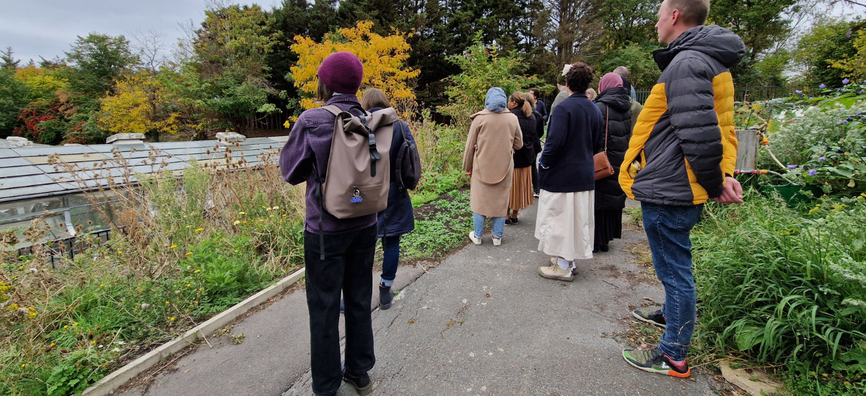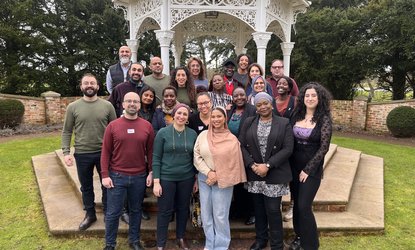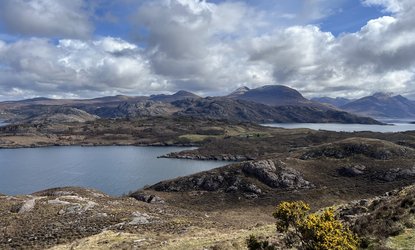Jenny Dadd, Funding Manager and Our Natural World Lead shares what we’ve been doing – working alongside our amazing partners – to champion peat as a climate superpower and restore peatland at scale. It’s the third in a series of blogs about our roadmap to improve our natural world.
What’s your marker of success? What makes you punch the air with that ‘back of the net’ moment of joy? I had one of those lovely moments last night. Sitting on my sofa. Watching Killing Eve (see 30 minutes in). BBC drama collided with work perfectly as a killer’s boots were linked to sphagnum moss – meaning that the killer had been in Scotland and with their feet on the mosses that go on to form peatlands. As the words ‘sphagnum troendelagicum’ emitted from the telly, I was up on my feet, punching the air. We have made it to prime-time telly and it’s a BBC drama!
And the past year has seen a bit of a drama on peatlands too. The ‘Cinderella habitat’ that was hardly spoken of beyond the realms of its steely champions a decade ago has suddenly arrived at the ball and in quite some style. If you’re not yet aware of why UK peat is so special, I wrote a blog about why it’s a climate superpower for World Bog Day. Moors for the Future also have a fantastic series of short video explainers about why blanket bogs are worth protecting.
Below, we share some of what our work has involved so far...
A headliner slot for peat at COP26
The Peatland Pavilion at COP 26 run by Global Peatlands Initiative and IUCN Peat Programme showcased peat and particularly UK peat to great effect - emphasising its climate superpower role as well as its numerous other astonishing properties. Peat as a bit of a headline act at COP. About time. No wonder they wanted to feature it in Killing Eve. It’s catching many an eye.
We had been headlining quietly on peat at Esmée before the launch of our new strategy in autumn 2020, as we supported partners like North Pennines AONB, Crichton Centre and the IUCN Peat Programme through grants looking after posts at those partner organisations. This gave us the appetite to do more and now peat sits proudly as one of our five current Our Natural World priorities. This signals a higher level of commitment from Esmée to UK peatlands and we like to think we have stuck to that.
New money for peatland restoration
Our roadmap approach, developed through extensive engagement with partners, commits us to being proactive in areas where we are can make a difference. In addition to supporting action to raise awareness of peatland, a key priority for us is to influence new models of securing the capital cost of peatland restoration. This includes working with the IUCN to support the development of the Peatland Carbon Code, but also supporting delivery partnerships to scale up the pipeline of restoration projects. The lack of projects at scale is one barrier to attracting larger levels of capital investment.
Our recent support to the Great North Bog collaboration of six Peat Partnerships totalled £2.75m in unrestricted core grants for posts that span the range of work needed from community awareness raising to unlocking private finance and training farmers to be custodians of peatlands. The support will be ‘transformational’ in the words of the collaboration. This initiative, covering much of the north of England and in partnership with landowners, communities, government, agencies, water companies, business, local authorities, private finance and other funders shows a scale of ambition we are keen to see much more of.
Developing peat partnerships
In Northern Ireland, together with DAERA, we’re supporting the development of the nation’s own peat partnership through the Northern Ireland Accelerating Peatland Restoration Project. It’s a collaborative project with the first phase of work headed up by Ulster Wildlife Trust. The James Hutton Institute is bringing their expertise to the project by satellite mapping the peat resource and ground truthing verification, which will mean that Northern Ireland can prioritise its own future peatland action with confidence. Importantly, farmers have also been involved in one of the fact-finding visits to other peat projects and peat partnerships and there have been visits to Wales, Scotland and England to begin the thinking about what NI’s peat partnership should look like.
This year, we are planning to build on this work and support the development of peatland partnerships in Northern Ireland and are exploring opportunities in Wales.
A legal ban on peat in horticulture by 2024
We also have a roadmap action on something that has vexed and alluded the environment sector over many years. A legal ban on peat in horticulture. It is not right that nations that make such strong climate commitments and pay to restore peatlands do not, paradoxically, take action on peat sales. Whilst we are pleased to see UK governments out to consultation on this topic, a legal ban should have been in place many years ago. Not only to protect the UK’s own peatland resource from mining, but to ban any imports of peat from abroad. We are working with partners including WWF Scotland, Plantlife, Snowdonia Society and The Wildlife Trusts and through support from horticultural and other NGOs, authors and consultants to drive this work forward. The National Trust has not used peat within in its estates and gardens for over 20 years now - and the results are evident - peat is not needed as a growing medium. Whilst many retailers are stocking peat alternatives, a full legal ban in all the countries of the UK by 2024 is being sought.
Restoring and protecting existing peatland
In Scotland, the Langholm Initiative (working on Tarras Valley Nature Reserve) has been supported as the first large scale community land purchase in the UK. Our support is towards staff posts there rather than land acquisition. A lot of the former shooting estate is on peatlands and plans are in place for community led peatland restoration which can act as a model for other schemes, locking in carbon and enabling Langholm’s response to the climate emergency as well as enabling restoration of nature and bringing work to the area.
Esmée’s Land Purchase Facility has provided social investment to enable acquisition of three peatland sites. Different to The Great North Bog, all three have a focus on lowland peat. This tends to be heavily farmed in England. Somerset Wildlife Trust has purchased Honeygar Farm on the Avalon Marshes which had a previous focus on cattle farming. Avalon Marshes are one of the few places left in England where peat mining still takes place for horticulture. NGOs are working together in partnership and at a scale which will show employment opportunities towards a just and green transition at the Marshes. Arable farming took place at Lakenheath in Suffolk, where RSPB has been able to acquire additional land with Esmée’s support. It will be able to re-wet it to lock in carbon and encourage nature’s return for Lakenheath’s many visitors. The same will happen at Horse Common in the New Forest which was also acquired by RSPB and contains peatland within a mosaic of other habitats.
What more can we do?
I’m really pleased we’re putting the Esmée welly behind peat and that the incredible power of peat is starting to get the recognition it deserves. In the words of Killing Eve’s MI6 boss, Carolyn: “Peat moss. Marvellous!”
So, what more can we do? These multiple interventions represent an initial phase we will seek to build on until at least 2025. If you have any ideas or opportunities of a peaty sort that you’d like to discuss with us, do feel free to get in touch: jenny.dadd@esmeefairbairn.org.uk. And if you do visit some of the UK’s peatland sites, don’t forget to take your wellies!
Learn more about what we want to achieve in our peat funding priority.






